The last two months of 2013 found Eileen and I back in North America, and, for much of that time, in Boca Raton, Florida, keeping an eye on my mother. Mom is, however, no invalid, and we were able to leave her to her own devices long enough to (among other things) take our combination nature walks/constitutionals along the familiar boardwalks of Wakodahatchee Wetlands and the Green Cay Nature Center in Delray. Here are some of the things we saw.
An Anhinga (Anhinga anhinga), still soaking wet, preens and basks in the sun.
A Glossy Ibis (Plegadis falcinellus) picks its way through the marshland vegetation.
A pair of Black-bellied Whistling-Ducks (Dendrocygna autumnalis) scratch and preen while an unconcerned male Blue-winged Teal (Anas discors) swims nonchalantly by.
Black-bellied Whistling-Ducks are among the most handsome of waterfowl....
...and I always appreciate it when they give me a chance for a really close look.
A fallen log provides this male Blue-winged Teal with an ideal place to stretch, preen, and, inadvertently, show off.
Wintering Northern Shovelers (Anas clypeata) are relatively uncommon in the South Florida wetlands (they are much more numerous along the Gulf Coasts of Texas an Louisiana), so I enjoyed the chance to get on close terms with this female. Shovelers are filter-feeders, using closely-packed plates, or lamellae, along their enormous beaks to strain water fleas and other tiny creatures from the surface.
After a bout of feeding, the Shoveler hauled out to rest next to a Common Gallinule (Gallinula galeata).
Pied-billed Grebes (Podilymbus podiceps) are charming creatures, though it does get irritating to hear uninformed visitors refer to them as ducks (DNA evidence suggests that the closest relatives of grebes are, of all things, flamingos - a finding that I would have loved to discuss with my late graduate supervisor Robert W. Storer, who was the world's leading authority on grebes back in the day).
Wintering Merlins (Falco columbarius) kept an eye out for prey from the tops of favourite dead trees...
...while Northern Harriers (Circus cyaneus) like this female coursed just above the grass tops.
When harriers do perch it is normally on the ground. The feathers on her face form a disk that gives her an owlish look, and serves much the same function as the facial disk in owls: funneling sound to the bird's ears. Harriers depend more on sounds - rodent squeaks and the like - to find their prey than do other hawks, which is probably the reason that their hunting flights are so much closer to the ground.
The wetlands are excellent places to see, and photograph, birds of prey: Ospreys (Pandion haliaetus), of course, because wetlands are where the fish are...
... but also the strikingly-marked Florida form of the Red-shouldered Hawk (Buteo lineatus), the commonest of South Florida's Buteos. Despite its perch on a Purple Martin house, the bird is not waiting for its occupants (who are away in their winter homes, and would probably be tough to catch anyway). Red-shoulders eat a wide range of small mammals, reptiles and amphibians, but are not usually bird hunters.
Wilson's Snipe (Gallinago delicata) are probably commoner in the wetlands (at least in winter) than they appear, but it is nonetheless satisfying to get close enough to one for a few detailed photographs. The details, mind you, are less necessary here than in some other parts of the world: rare strays aside, this is the only North American snipe.
Female Red-winged Blackbirds (Agelaius phoeniceus) are smaller, and subtler in colour and pattern, than the flamboyant males. Beginner birders often mistake them for a sort of sparrow.
These are hardly the best shots possible of an Eastern Phoebe (Sayornis phoebe), but I couldn't resist the dive from its perch. Like most of the New World Tyrant Flycatchers, phoebes catch their insect prey in mid-air.
Palm Warblers (Setophaga palmarum) are the commonest wintering songbirds in South Florida. They nest (despite their inappropriate names) in the boreal forest, far to the north.
The wetlands are also good spots to see some common Florida dragonflies. Common Green Darners (Anax junius) coursed back and forth over the water, rather like harriers, but rarely come close enough for a decent photograph.
It is a lot easier to get a closeup of a Blue Dasher (Pachydiplax longipennis), one of the commonest dragonflies in North America.
Both the Darner and the Dasher are widespread (I see them both regularly in Ontario), but the Pin-tailed Pondhawk (Erythemis plebeja) is a southern specialty. Within the United States it is only found in central and southern Florida and southern Texas, though it ranges south as far as Argentina.
This mating pair have not yet assumed the "wheel" position, which the female must do if she is to pick up the male's sperm. Meanwhile, he keeps a firm lock on her with the terminal appendages at the end of his abdomen, and does the perching for both of them.
The lovely Halloween Pennant (Celithemis eponina) ranges north to southern Canada, but I have never seen it there. It are much easier to find in Florida. A perched Halloween Pennant sways back and forth, displaying his wings at different angles (I have watched a number of Asian dragonflies with patterned wings do much the same thing). This the most butterfly-like of dragonflies, and according to Dennis Paulson's Dragonflies of the East (Princeton University Press, 2011) some have speculated that it may be a mimic of the distasteful and toxic Monarch Butterfly (Danaus plexippus). If so, this may be proof that some insect-eating birds have remarkably poor eyesight.



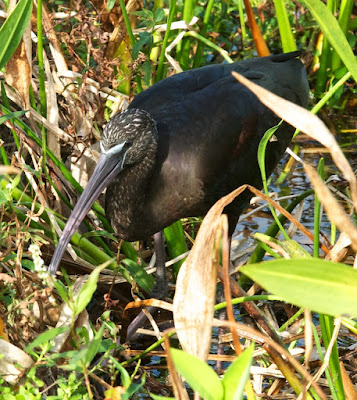








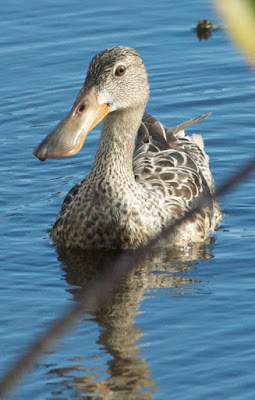
















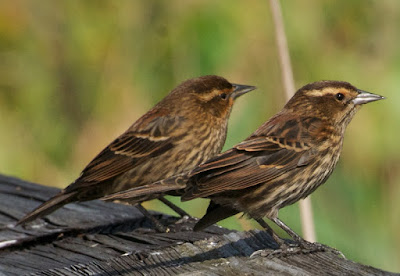



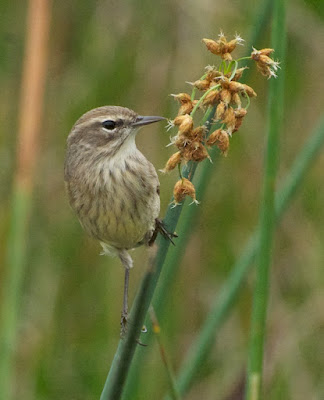
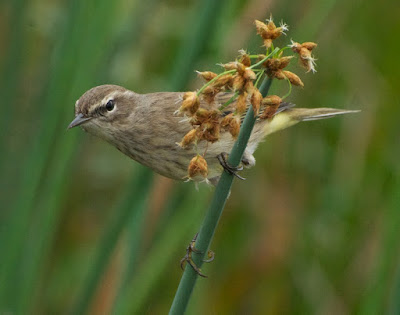



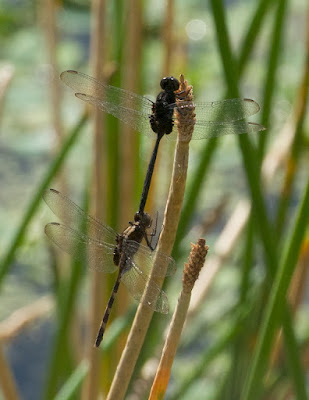


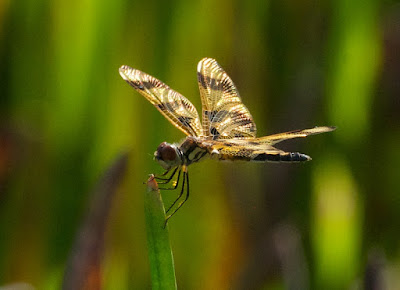

No comments:
Post a Comment